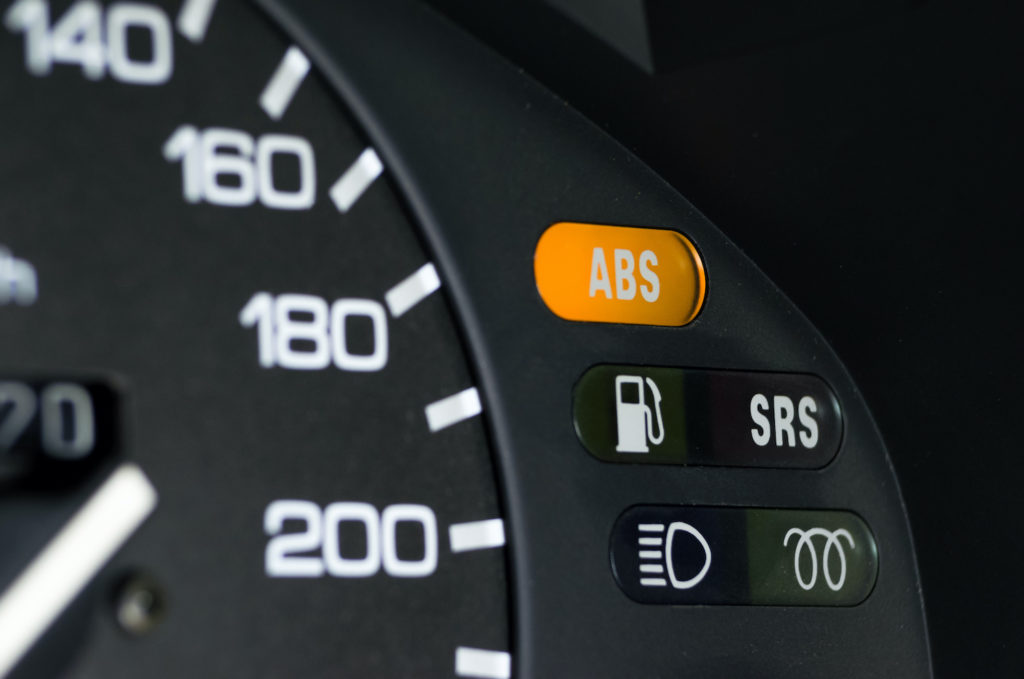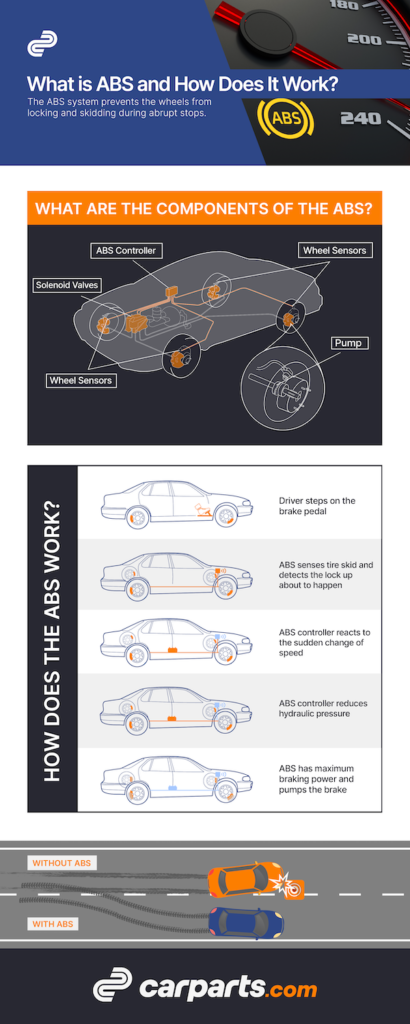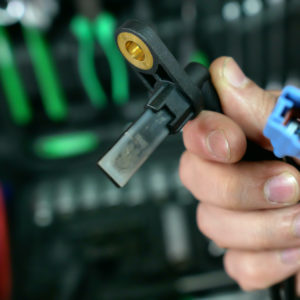In the past, suddenly hitting the brakes could make the wheels lock up and skid. Once this happens, it can be challenging to regain control of the car. This is dangerous not only to the people inside the vehicle, but also to everyone else on the road.
Luckily, modern vehicles are equipped with a standard safety feature that prevents wheel lock-up. It is known as the antilock brake system (ABS).

What is ABS?
The ABS system prevents the wheels from locking during abrupt stops. It lessens the danger of skidding, allowing the car to stop without going sideways. The system also allows drivers to retain enough steering control to avoid crashing into other cars during sudden and heavy braking.
The ABS system can also improve braking on slippery roads. It does this by monitoring the relative speed of the wheels against each other. The gathered data is used to modulate brake pressure, which helps control slippage and maintain traction when braking.
Here’s a fun fact about the ABS: it was first used in the 1950s on an aircraft. It became a part of a vehicle in the 1970s, specifically on a 1970 Lincoln Continental. Drivers were given the option to get “Sure-Track,” a rear-wheel braking system for their vehicle.

ABS: A Mandatory Safety Feature
ABS became a mandatory feature on all cars starting September 2013. The National Highway Traffic Safety Administration (NHTSA) made it a requirement together with electronic stability control (ESC) systems under the provisions of the March 2007 Federal Motor Vehicle Safety Standard (FMVSS) No. 126.
Although this safety feature was mandated fairly recently, antilock brake systems were already commonplace among car manufacturers. Some vehicles built in the 1990s and 2000s (and even a few in the 1980s) already had them.

What is an ABS Sensor?
An ABS sensor, also known as a wheel speed sensor, is one of the four primary components of an ABS system. It monitors the speed of the wheels and gathers data that is used by the ABS controller to prevent tire slip.
What are the Components of the ABS?
There are four primary parts involved in an antilock brake system: the pump, controller, wheel speed sensors, and solenoid valves. All these components work together to ensure the car can stop at the shortest distance possible without its wheels locking when braking.
- Pump – Most antilock brake systems use a pump to restore brake fluid pressure to the brake lines after the valves have been released.
- Controller – The electronic brake control module (EBCM) is the brain of the ABS. Also known as an electronic brake module (EBM) and controller antilock brakes (CAB), it uses data from the sensors to determine whether or not to pump the brakes.
- Wheel speed sensors – These sensors monitor how fast the wheel or wheels are rotating.
- Solenoid valves (inside the modulator assembly) – Valves in the brake line allow, block, and release pressure on the brakes by assuming three different positions

How Does the ABS Work?
The ABS controls tire slip by keeping track of the relative deceleration rates of the wheels during braking. If one wheel slows faster than the other wheels or the threshold set by the ABS, the system perceives this as the wheel starting to slip. If the tire is on the verge of slipping, it might be in danger of locking and losing traction.
The ABS responds by decreasing hydraulic pressure to the brake on the affected tire. This lets the wheel momentarily speed up to gain traction. Once the traction is regained, brake pressure is reapplied to slow it. This cycle repeats until the driver eases pressure on the brake pedal or the vehicle stops.

How Do I Use the ABS Brake System?
Using the ABS is a lot easier than it sounds, mostly because it’ll do most of the work for you. When you’re driving on a slippery road or coming to an abrupt stop, you’ll most likely feel the ABS vibrating. This means the system is working as it should, and you don’t have to pump the brakes yourself. All you have to do is apply your brakes as you steer the vehicle.
ABS Limitations
There are two instances where the capabilities of an ABS is limited. It may not be able to provide the shortest stopping distances given the following circumstances:
Straight stops made on smooth, dry pavement by a skilled driver
On a smooth, dry road, an expert driver can hold the wheels consistently closer to the ideal slip rate than the ABS. This is because current antilock braking systems allow tire slips as low as 5%, a rate lower than the maximum achievable tire traction.
However, for the average driver, the ABS will stop the vehicle in the shortest distance possible.
Braking on loose gravel or in deep snow
When driving under these two circumstances, the ABS won’t be able to provide the shortest stops. This is because a locked wheel would be able to stop the car faster than the ABS can. Loose debris can build up on the wheel’s front and form a wedge that could stop the vehicle.
However, with an active ABS, this wedge won’t form. Some vehicles have an option to turn the ABS off when driving on these roads to allow shorter stopping distances.

What Does the ABS Light on the Dashboard Mean?
An illuminated ABS warning light means the antilock brake system has been deactivated because of an error. If the car also has stability control and traction control systems, these systems will be shut off because they depend on the same wheel speed sensors.
The ABS light should briefly activate every time the car is started as part of a system check. If the light stays on, this means there is a potential problem, and the system has been shut down.
Driving with an illuminated ABS warning light is dangerous, especially when traveling on slippery roads. It typically indicates that you have diminished steering control and increases the risk of your wheels locking during sudden brakes.
To switch off this warning light, refer to a repair manual for the appropriate steps. If you don’t want to DIY, you can always bring your car to an auto repair shop and let a mechanic fix the problem.

How To Maintain Your ABS
A malfunctioning ABS puts you at greater risk of getting into an accident, so it’s important to maintain it to ensure everything works as intended. Here are helpful tips on how to maintain your vehicle’s ABS:
Check Your Brake Fluid Levels Regularly
Most manufacturers recommend replacing your brake fluid every two or three years. However, it’s a good idea to check your brake fluid every three or four months, especially if you live in a humid region.
Low brake fluid can cause your regular brakes and ABS to malfunction, which can put you, your passengers, and everybody else on the road in danger.
Inspect Wheel Speed Sensors
Constant exposure to dirt and debris can cause the wheel speed sensors to malfunction and send inaccurate readings to the ABS. This can cause the ABS to work intermittently and trigger the ABS light on your dashboard.
If this happens, try cleaning the sensor with a dry microfiber towel or a wire brush. Avoid using any cleaning solutions with harsh chemicals that can damage the sensor.
Schedule Regular Brake Inspections
While the exact interval can vary depending on your manufacturer, a good rule of thumb is to have your brakes checked every six months. Having a mechanic inspect your brakes is key to catching ABS issues before they get worse.
Shop for High-Quality Brake Parts Online
The ABS will only be able to do its job if the other parts of your braking system are able to do theirs. So when it’s time to shop for various brake parts, CarParts.com is exactly where you need to be.
We have a wide selection of high-quality brake parts designed to deliver maximum braking performance on any surface. Simply enter your vehicle’s specifications into our vehicle selector to find compatible products for your ride.
Never worry about going over budget when you shop from us. All our products come with a low-price and lifetime replacement guarantee, helping you get the best value for your money.
Don’t miss out on the best deals on the market, and shop for high-quality brake parts today!
Any information provided on this Website is for informational purposes only and is not intended to replace consultation with a professional mechanic. The accuracy and timeliness of the information may change from the time of publication.































